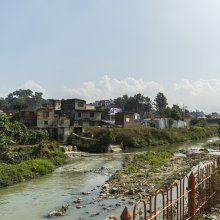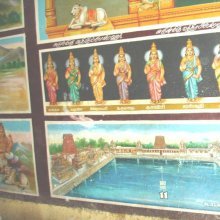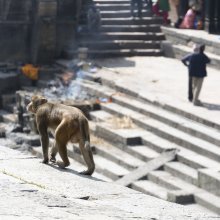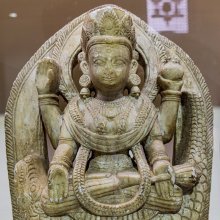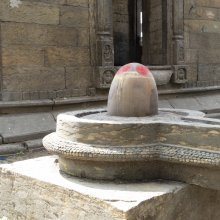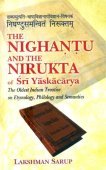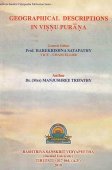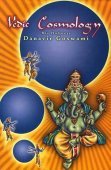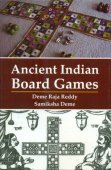River: 4 definitions
Introduction:
River means something in Buddhism, Pali, Hinduism, Sanskrit. If you want to know the exact meaning, history, etymology or English translation of this term then check out the descriptions on this page. Add your comment or reference to a book if you want to contribute to this summary article.
Images (photo gallery)
(+40 more images available)
In Hinduism
Natyashastra (theatrics and dramaturgy)
Source: Shodhganga: Elements of Art and Architecture in the Trtiyakhanda of the Visnudharmottarapurana (natya)Rivers (as in, the natural phenomenon) are associated with Patāka-hasta: one of the twenty-two Single-hand Gestures (in Indian Dramas) (known as asaṃyuktahastas), according to the Viṣṇudharmottarapurāṇa, an ancient Sanskrit text which (being encyclopedic in nature) deals with a variety of cultural topics such as arts, architecture, music, grammar and astronomy.—The word patāka indicates dhvaja in Sanskrit which means flag or banner. [...] In the Abhinayadarpaṇa, it is said that the patākahasta is used to denote the beginning of a drama. Moreover, this hand posture is used to symbolize some natural phenomenon like cloud, forest, bosom, river, wind etc.

Natyashastra (नाट्यशास्त्र, nāṭyaśāstra) refers to both the ancient Indian tradition (shastra) of performing arts, (natya—theatrics, drama, dance, music), as well as the name of a Sanskrit work dealing with these subjects. It also teaches the rules for composing Dramatic plays (nataka), construction and performance of Theater, and Poetic works (kavya).
Vastushastra (architecture)
Source: Shodhganga: Elements of Art and Architecture in the Trtiyakhanda of the Visnudharmottarapurana (vastu)Rivers should surround the construction site of Temples, according to Puranic lore such as the Bhaviṣyapurāṇa and Viṣṇudharmottarapurāṇa, an ancient Sanskrit text which (being encyclopedic in nature) deals with a variety of cultural topics such as arts, architecture, music, grammar and astronomy.—Selection of proper site is very necessary for any construction. It is the prime and first duty of the constructor or the proprietor to find out a perfect land which should possess the required qualities. [...] In the Bhaviṣyapurāṇa it is stated that, the abode of God should be established near the forest and the place should be full of rivers, mountains and springs.

Vastushastra (वास्तुशास्त्र, vāstuśāstra) refers to the ancient Indian science (shastra) of architecture (vastu), dealing with topics such architecture, sculpture, town-building, fort building and various other constructions. Vastu also deals with the philosophy of the architectural relation with the cosmic universe.
Shilpashastra (iconography)
Source: Shodhganga: Elements of Art and Architecture in the Trtiyakhanda of the Visnudharmottarapurana (shilpa)Rivers (personified) follows specific guidelines of ancient Indian Painting (citra), according to the Viṣṇudharmottarapurāṇa, an ancient Sanskrit text which (being encyclopedic in nature) deals with a variety of cultural topics such as arts, architecture, music, grammar and astronomy.—In the Viṣṇudharmottarapurāṇa, the technique of personification is seen to be used in the context of Painting also. According to the Viṣṇudharmottarapurāṇa, rivers are shown in a picture through human forms along with their vehicles, bent knees and carrying some pitchers filled with water. It reminds of the conversation of the rivers Tamasā and Muralā in the third act of the Uttararāmacarita.

Shilpashastra (शिल्पशास्त्र, śilpaśāstra) represents the ancient Indian science (shastra) of creative arts (shilpa) such as sculpture, iconography and painting. Closely related to Vastushastra (architecture), they often share the same literature.
In Buddhism
Tibetan Buddhism (Vajrayana or tantric Buddhism)
Source: ORA: Amanaska (king of all yogas): (Tibetan Buddhism)Rivers (in Sanskrit: Nadī) can be controlled by one having the Siddhi (power) of Speech, according to verse 14.24bd-27 of the Laghuśaṃvara, an ancient Buddhist Yoginī Tantra.—Accordingly: “The Sādhaka [who has] the Siddhi of speech can certainly attract a king or queen by [merely] thinking [it]. [...] And he can stop a river (nadī), a cart, a machine [like a water-wheel,] the ocean, elephants and horses, clouds, a man or bird merely by means of his speech. He achieves everything which he desires by his speech”.

Tibetan Buddhism includes schools such as Nyingma, Kadampa, Kagyu and Gelug. Their primary canon of literature is divided in two broad categories: The Kangyur, which consists of Buddha’s words, and the Tengyur, which includes commentaries from various sources. Esotericism and tantra techniques (vajrayāna) are collected indepently.
See also (Relevant definitions)
Starts with (+6): River acacia, River angee, River bank, River bean, River birch, River bushwillow, River cane, River combretum, River euphorbia, River farm grass, River grass, River guarri, River hawthorn, River karee, River litchi, River mangrove, River poison tree, River pumpkin, River putat, River red gum.
Ends with: Avuriver, Cape river, Chiriver, Driver, Kunriver, Myrtle-of-the-river, Pathiriver.
Full-text (+5573): Yamuna, Ganga, Sindhu, Narmada, Sarayu, Sarasvati, Kaveri, Godavari, Bhimarathi, Shatadru, Tungabhadra, Sarit, Payoshni, Mandakini, Tamraparni, Candrabhaga, Mahanadi, Tapi, Vitasta, Nadi.
Relevant text
Search found 398 books and stories containing River; (plurals include: Rivers). You can also click to the full overview containing English textual excerpts. Below are direct links for the most relevant articles:
Rivers in Ancient India (study) (by Archana Sarma)
2. The rivers in the Purāṇic Literature < [Chapter 5 - Rivers in the Purāṇic Literature]
14. The river Gomatī and its present status < [Chapter 6 - Changing trends of the Rivers from Vedic to Purāṇic Age]
Tattvartha Sutra (with commentary) (by Vijay K. Jain)
Verse 3.22 - The direction of the remaining rivers < [Chapter 3 - The Lower World and the Middle World]
Verse 3.23 - The tributaries of the rivers < [Chapter 3 - The Lower World and the Middle World]
Verse 3.21 - The direction of the first of each pair of rivers < [Chapter 3 - The Lower World and the Middle World]
Puranic encyclopaedia (by Vettam Mani)
Settlement in Early Historic Ganga Plain (by Chirantani Das)
Part 3 - Rivers and other water sources of Vārāṇasī < [Chapter V - Rise of Vārāṇasī as a Nodal Centre]
Part 4 - River and the topography of Vārāṇasī < [Chapter V - Rise of Vārāṇasī as a Nodal Centre]
Part 10 - Water-Drainage System (regarding Rājagṛha) < [Chapter I - The Case Study of Rājagṛha]
The Skanda Purana (by G. V. Tagare)
Chapter 297 - Greatness of Ṛṣitoyā < [Section 1 - Prabhāsa-kṣetra-māhātmya]
Chapter 92 - The Story of Narmadeśvara < [Section 2 - Uttarārdha]
Chapter 12 - Eulogy of Narmadā < [Section 3 - Revā-khaṇḍa]
Related products
(+2 more products available)
